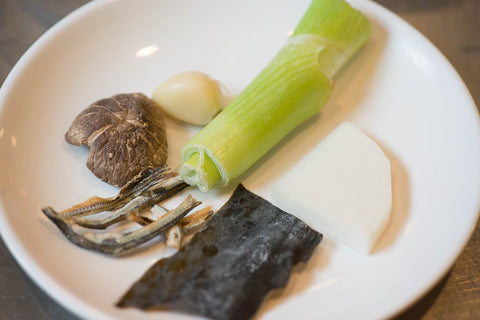8 Ways To Cook With Kombu

Kombu is an edible variety of kelp that features in many Korean, Chinese and Japanese dishes. It is called as ‘dasima’ in Korean and ‘haidai’ in Chinese, featuring in many east Asian dishes.
If you’re new to cooking with Kombu, we’ve put together 8 ways to cook with Kombu to help you get started. And even if you’re a kombu expert, you may well find something you haven’t tried before!
The image above shows the different varieties of kombu for sale in a Japanese food market.
What is Kombu?
Kombu is an edible sea vegetable from the brown algae family. It’s similar in flavour to Nori seaweed and contains many of the same vitamins and minerals, however, nori is seaweed and Kombu is kelp.
Most Kombu is harvested in the seas of Korea and Japan, mainly coming from Hokkaido, an island in northern Japan. Its flavour differs depending on the variety you choose, however generally Kombu it has a subtle, briny taste, extremely rich in umami.
How can you cook with Kombu?
There are many ways that you can cook with Kombu, so take a look at our favourite - and perhaps unexpected - ways to use this versatile ingredient...
Kombu stocks and soups
Japanese dashi stock
One of the most famous ways to cook with kombu is in soups made from dashi stock - the Japanese stock that forms the base of many of the cuisine’s dishes.
Dashi is usually made from sheets of kombu, along with bonito flakes infused together in hot water. Vegetarian dashi uses shiitake mushrooms with the sheet kombu instead of the bonito flakes to add extra umami.

A quicker way to make a broth is with kombu powder - a powdered form of kombu that holds plenty of iodine and umami flavour. Add miso, and soy along with the kombu powder to make a steaming bowl of delicious and healthy soup.
Similarly, a seasoned variety of kombu powder is available - kombudashi - to make dashi stock instantly.

Ready-made kombu soup bases
Similar to the soup and dashi, adding kombu to noodle broths adds another umami dimension. Our anchovy kombu flavour soup base is a well-balanced seasoning that works brilliantly in spicy Korean noodle broths and hot pots.
Kombu soup bases can also used to make an acorn-based jelly, known as dotorimuk, which is sliced and served as a salad with slivered carrots, spring onions, Korean red pepper powder, soy sauce, sesame oil, and sesame seeds.
Traditionally acorn powder is used to set the kombu soup base, but instead, you could use agar agar or arrowroot.
Kombu sheets for steaming fish on the BBQ
Dried Kombu is perfect for wrapping around fish before popping it on the barbeque, or eating alone sashimi-style. This dark, olive-coloured kombu is cultivated on ropes off the Japanese coast, harvested and then sun-dried, giving it a white, sea salt residue on the surface which shouldn’t be rinsed off, but gently wiped off with damp kitchen paper.
Before you wrap the kombu around your fish, rehydrate it for 8-10 minutes in water so that the seaweed becomes malleable. The fish will gently steam inside the leaf.
Kombu in tea
In its powdered form, kombu powder also be mixed with Japanese green tea to make the hot Japanese drink, kombucha, not to be confused with the fermented fruit drink that is also called kombucha in the west!
Kombu in baking
Seaweed bread is becoming more popular, and it’s extremely easy to transform your loaves into umami-rich superfoods. Just blend a couple of tablespoons of kombu powder with flour and proceed according to your usual recipe.
Alternatively you could try blending the kombu powder with butter to drizzle over a savoury marmite and roast onion loaf.
Kombu butter
To make an umami rich butter for serving with steaks, lamb or even roast vegetables, just blend kombu powder together with some softened butter. Form into a cylinder using clingfilm, and refrigerate. Cut into slices and serve at the table.
Kombudashi powder as a seasoning
You can use kombudashi powder to make instant vegetarian miso soup, however it’s also great for using more widely in cooking. Dashi powder is a great store cupboard ingredient for instantly whipping up Japanese sauces.
To create a perfect dipping sauce, you’ll need 1 cup dashi stock (made from dashi powder and water), 3 tablespoons soy sauce, 2 tablespoons mirin and some freshly grated daikon. Simply blend together until smooth and serve with Japanese skewers or tempura.
Alternatively use a few pinches of the dashi powder to season scrambled eggs, or in pancake batter to make okonomiyaki or takoyaki.

Adding flavour to rice
Add a small matchbox size piece of sheet kombu to the cooking water for rice to give it an extra flavour dimension.
Kombu to soften beans
Another great way to cook with kombu is to soften beans in broths and stews. The amino acids in kombu help soften the beans and make them more digestible and less gassy. All you need to do is simply add Dried Kombu Seaweed to your cooking water. The deep flavor and rich depth will also season the beans, adding a umami edge.
To explore our full range of seaweed, including kombu and nori, take a look at our seaweed products. For more information on Japanese cooking, you can also read up on how to make the best Japanese food at home.




